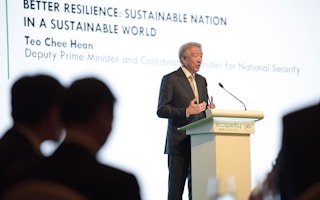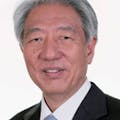Since the 1970s, economic development has helped to lift billions of people out of poverty. Social indices of human development such as healthcare and education have improved significantly.
To continue reading, subscribe to Eco‑Business.
There's something for everyone. We offer a range of subscription plans.
- Access our stories and receive our Insights Weekly newsletter with the free EB Member plan.
- Unlock unlimited access to our content and archive with EB Circle.
- Publish your content with EB Premium.
But this progress is not even, and important challenges remain. Social inequality, education and work opportunities for women, and youth unemployment are still areas of concern for many countries.
Rising populism and protectionism in several advanced economies, technological disruptions, and new transnational security and pandemic threats add more complexity and uncertainty to health, safety, and development.
Our environment is also under stress. Since 1972, the world population has grown from 3.8 billion to 7.3 billion in 2015, and is expected to grow to 9.7 billion by 2050. More than 54 per cent of the global population already lives in urban areas.
Access to clean air, clean water, power, and sanitation are challenges in many countries. Low-lying coastal communities such as Singapore are also more vulnerable to rising sea levels due to climate change.
Individuals, companies, countries, and the global community will need to work together to develop solutions for sustainable development.
As a small, densely populated island nation with no natural resources, Singapore’s own sustainable development experience has focused on four key areas: Building a sustainable economy; creating a sustainable living environment; ensuring sustainable development for our people; and contributing to international collaboration.
Sustainable economy
Economic growth generates the resources to invest in education, research and development, security, infrastructure, and public services.
With no natural resources, Singapore has had to be resourceful to make a living for ourselves. This has entailed finding ways to create and add value, producing goods and services that are in demand by others, and making careful use of resources.
This has required integrated and long-term planning to optimise resources such as budget, land, manpower, energy, and more recently, carbon emissions, to ensure sustainable growth.
We made early choices to turn away very pollutive industries and took early action to switch to natural gas, the cleanest form of fossil fuel, for power generation. Today, we are among the 20 most carbon efficient countries in the world.
We will intensify our efforts as we work towards achieving our commitment under the Paris Agreement. We will reduce emissions intensity by 36 per cent from 2005 levels by 2030, and stabilise emissions with the aim of peaking by then.
We plan to introduce a carbon tax from 2019 so that those who emit the most carbon emissions will bear the cost to our environment and be encouraged to reduce their emissions. There is also much potential for our industries to save costs as we raise energy efficiency.
The carbon tax will also help align the costs and benefits of reducing emissions. We are also scaling up deployment for solar, aggregating demand across our agencies and testing floating solar photovoltaics on our reservoirs.
These plans can help us to move towards a low-carbon society, and also be a Living Laboratory for businesses, agencies, and research institutes to develop new products and services for the global economy.
According to the recently launched ‘Better Business, Better World” Asia report, opportunities in sustainability could contribute US$12 trillion to global GDP and create 380 million new jobs by 2030. I encourage our businesses to seize these opportunities.
Sustainable living environment
Our pioneer generation had a vision for a clean, green and sustainable Singapore for all Singaporeans. They instilled in all of us the consciousness that this little island is all that we have, and we have to look after it well.
Over the past 50 years, we have seen vast improvements in our housing, water, public health, and sanitation. Today, we are a City in a Garden with about 47 per cent green cover in Singapore. More than 80 per cent of households are within a 10-minute walk from a park.
We have 72 hectares of rooftop gardens and green walls today, and aim to triple this by 2030. These plans are outlined in our Sustainable Singapore Blueprint.
I have also just launched the Public Sector Sustainability Plan, which will catalyse sustainable practices, generate demand for green products and services, and encourage our public officers to think green. These initiatives will achieve a green and sustainable living environment for all Singaporeans.
“
With no natural resources, Singapore has had to be resourceful to make a living for ourselves. This has entailed finding ways to create and add value, producing goods and services that are in demand by others, and making careful use of resources.
Sustainable development for our people
Our people are our precious and only resource, and investing in them is of utmost importance.
Since the 1960s, we have worked to achieve mass education at the primary, secondary, and tertiary levels. Our next frontier is mass continuing education to prepare for the future of work. Rapid technological advances will change the nature of work and the skills required.
The knowledge and skills we acquire through conventional pre-employment education during the first 20 years of our lives will need to be refreshed to last a working life of over forty years.
Our workers must be prepared to constantly upskill and reskill, and move into new jobs and industries several times in their working lives. SkillsFuture Singapore will work closely with our associations, unions, and companies to support our workers to deepen and refresh their skills at key points in their careers.
International collaboration
Nations also need to work together to address global challenges. Issues such as transboundary air pollution or pandemics require a regional response, while others such as climate change require the contribution of all countries.
Singapore remains committed to the Paris Agreement and supports the United Nations 2030 Agenda for Sustainable Development, which provides a framework to guide national efforts in achieving the 17 Sustainable Development Goals.
In support of this agenda, we have trained more than 112,000 officials from over 170 developing countries in key areas such as sustainable urban, water, and human resource management, health, and education.
We will continue to share our sustainable development policies and expertise through leadership seminars in policymaking, workshops on urban governance in cities, and water and sanitation projects.
In the course of our development journey, Singapore has benefited from the experience of many countries as we developed, and we continue to do so. We hope that our collaborations in sustainable development can, in a similar way, make a small contribution to the development paths and journeys of other countries.
Through international partnerships, we can collectively find more efficient, more comprehensive, and more sustainable solutions to address global challenges.
The four aspects of sustainable development that I have highlighted work in combination with one another. Strong partnership between the public, private, and people sectors will be required to shape a sustainable future for all of us.
Eco-Business is a content partner for Temasek’s Ecosperity sustainable development event, which was held on Monday 5 June in Singapore.















